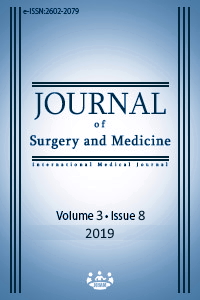Can single-step dilatation technique in pediatric percutaneous nephrolithotomy be an effective alternative to stepwise dilatation?
Keywords:
Single-step dilatation, Nephrolithiasis, Percutaneous nephrolithotomy, FluoroscopyAbstract
Aim: The most important stage of percutaneous nephrolithotomy (PNL), which is an effective and reliable method in the treatment of large and complex kidney stones, is to create a suitable and effective tract after the accessory is provided. For this purpose, different techniques such as Amplatz, baloon and Alken dilators have been described. We aimed to compare the efficacy and safety of single-step Amplatz dilatation technique with stepwise Amplatz dilatation technique in pediatric PNL patients.
Methods: This is a retrospective cohort study. We evaluated the data from 75 PNL operations performed on 72 pediatric patients in our center within the last decade. The data from single-step dilation technique patient group (group 1, n: 41) and the stepwise dilatation technique patient group (group 2, n: 34) was compared in terms of durations of fluoroscopy and surgery, stone-free and complication rates, pre and postoperative hematocrit levels and blood transfusions rates.
Results: There was no significant difference between the groups in terms of demographic data, mean stone burden, duration of surgery, decrease in hematocrit, blood transfusion rates, stone-free rate and complication rates. The median fluoroscopy durations of group 1 and group 2 were 120 and 220 seconds, respectively. Duration of surgery and fluoroscopy were significantly shorter in the single-step dilatation group
Conclusion: PNL is a safe and effective procedure for pediatric stone diseases. Performing this procedure with a single-step dilatation technique ensures that children are less exposed to radiation.
Downloads
References
Türk C, Neisius A, Petrik A, C. Seitz, A. Skolarikos, A. Tepeler, K. Thomas. Guidelines on urolithiasis. European Association of Urology; 2018. http://www.uroweb.org/guideline/urolithiasis [Accessed 13 November 2018]
Wadhwa P, Aron M, Bal CS, Dhanpatty B, Gupta NP. Critical prospective appraisal of renal morphology and function in child¬ren undergoing shockwave lithotripsy and percutane¬ous nephrolithotomy. J Endourol. 2007;21(9):961-6.
Lao M, Kogan BA, White MD, Feustel PJ. High recurrence rate at 5-year followup in children after upper urinary tract stone surgery. J Urol. 2014;191(2):440-4.
Amirhassani S, Mousavi SHB, Kashkouli AI, Torabian S. Comparison of the safety and efficacy of one-shot and telescopic metal dilatation in percutaneous nephrolithotomy: A randomized controlled trial. Urolithiasis. 2014;42:269–73.
Suelozgen T, Isoglu CS, Turk H, Yoldas M, Karabicak M, Ergani B, et al. Can we use single-step dilation as safe alternative dilation method in percutaneous nephrolithotomy? Urology. 2017;99:38-41.
Tefekli A, Karadag MA, Tepeler K, Sari E, Berberoglu Y, Baykal M, et al. Classification of percutaneous nephrolithotomy complications using the modified Clavien grading system: looking for a standard European. Urology. 2008;53:184-90.
Guan N, Fan Q, Ding J, Zhao Y, Lu J, Ai Y, et al. Melamine-contaminated powdered formula and urolithiasis in young children. N Engl J Med. 2009;360(11):1067-74.
Muslumanoglu AY, Binbay M, Yuruk E, Akman T, Tepeler A, Esen T, et al. Updated epidemiologic study of urolithiasis in Turkey. I: changing characteristics of urolithiasis. Urol Res. 2011;39:309–14.
Woodside JR, Stevens GF, Stark GL, Borden TA, Ball WS. Per¬cutaneous stone removal in children. J Urol. 1985;134(6):1166-7.
Frattini A, Barbieri A, Salsi P, Sebastio N, Ferretti S, Bergamaschi E, et al. One shot: a novel method to dilate the nephrostomy access for
percutaneous lithotripsy. J Endourol. 2001;15:919-23.
Safak M, Göğüş C, Soygür T. Nephrostomy tract dilatation using a balloon dilatation percutaneous renal surgery. Urol Int. 2003;71:382–4.
El-Shazly M, Salem S, Allam A, Hathout B. Balloon dilator versus telescopic metal dilators for tract dilatation during percutaneous nephrolithotomy for staghorn stones and calyceal stones. Arab J Urol. 2015;13:80–3.
Penbegül N, Tepeler A, Sancaktutar AA, Bozkurt Y, Atar M, Yildirim K, Söylemez H. Safety and effi cacy of ultrasound-guided percutaneous nephrolithotomy for treatment of urinary stone disease in children. Urology. 2012;79:1015-9.
Sofikerim M, Demirci D, Gülmez I, Karacagil M. Does previous open nephrolithotomy affect the outcome of percutaneous nephrolithotomy. J Endourol. 2007;21:401-3.
Amjadi M, Zolfaghari A, Elahian A, Tavoosi A. Percutaneous nephrolithotomy in patients with previous open nephrolithotomy: one shot versus telescopic technique for tract dilatation. J Endourol. 2008;22:423-5.
Fraser M, Joyce AD, Thomas DF, Eardley I, Clark PB. Minimally invasive treatment of urinary calculi in children. BJU Int. 1999;84:339-42.
Özden E, Şahin A, Tan B, Doğan HS, Eren MT, Tekgül S. Percutaneous renal surgery in children with complex stone. J Pediatr Urol. 2008;4:295-8.
Li Y, Yang L, Xu P, Shen P, Qian S, Wei W, et al. One-shot versus gradual dilation technique for tract creation in percutaneous nephrolithotomy: a systematic review and meta-analysis. Urolithiasis. 2013;41:443-8.
Desai MR, Kukreja RA, Patel SH, Bapat SD. Percutaneous nephrolithotomy for complex pediatric renal calculus disease. J Endourol. 2004;18(1):23-7.
Kapoor R, Solanki F, Singhania P, Andankar M, Pathak HR. Safety and efficacy of percutaneous nephrolithotomy in the pediatric population. J Endourol. 2008;22:637-40.
Benson JS, Hart ST, Kadlec AO, Turk T. Small-bore catheter drainage of pleural injury after percutaneous nephrolithotomy: feasibility and outcome from a single large institution series. J Endourol. 2013;27(12):1440-3.
Downloads
- 1245 1859
Published
Issue
Section
How to Cite
License
Copyright (c) 2019 Murat Uçar, Erdem Kısa, Fatih Çelik, Cem Yücel, Tufan Süelözgen, Yusuf Özlem İlbey, Nizamettin Kılıç
This work is licensed under a Creative Commons Attribution-NonCommercial-NoDerivatives 4.0 International License.
















